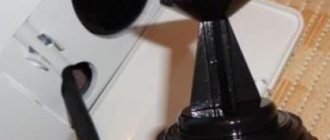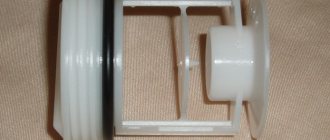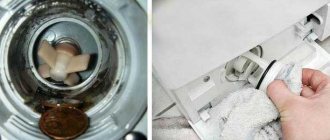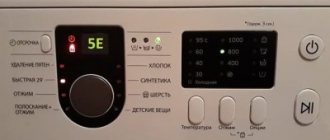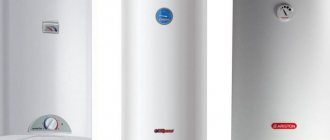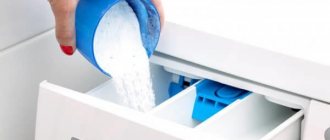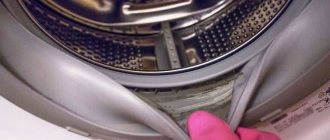Is it necessary to clean the powder compartment?
Before we figure out how to clean the powder compartment in a washing machine, let’s answer the question - is it necessary to do this?
Unfortunately, if you do not clean the washing powder compartment on time, mold and scale will appear in it. You may not see it, but you will definitely smell an unpleasant odor from things. There may also be problems with the operation of the washing machine.
If you do not clean the powder compartment, its surface becomes rough. Because of this, the powder does not enter the washing machine from the tray, but remains in it. This is how the plaque layer quickly thickens and hardens. And you wash with virtually no washing powder.
Therefore, it will be better if you clean the powder compartment after each wash.
Why does powder remain in the tray?
When washing, the washing powder is not completely washed out of the dispenser; its remnants stick to the walls, turning into limescale. That is why it is recommended to clean the washing machine tray on a regular basis.
Common reasons why detergent is not washed out of the washing machine tray:
- Insufficient pressure. Perhaps the washing machine does not have enough power to remove the detergent completely from the dispenser. In this case, it can be configured.
- Filter clogged. Sometimes the reason for the accumulation of detergent in the tray is a clogged washing machine filter. It also needs to be descaled.
- Plenty of powder. Do not pour more substance into the compartment than indicated on the package.
- Incorrect position of the machine. Perhaps the washing machine is tilted due to an uneven surface, so the product is not completely washed off during washing. In this case, the equipment must be placed in a strictly vertical position.
- Damages in the control panel. They can contribute to the malfunction of the equipment, which leads to contamination in the dispenser.
- Exhaust valve failure. Calcified plaque can remain in the compartment for a long time for this reason. A faulty washing machine valve should be replaced at a service center.
In case of some malfunctions, you cannot do without the help of a specialist.
How to remove the washing powder compartment from a washing machine
You can clean the powder compartment without removing it from the washing machine. But you can clean the powder tray more effectively if you pull it out.
You should pull out the powder compartment very carefully, according to the instructions, so as not to break it.
If handled carelessly, the powder tray may crack.
In most washing machines, to reach the powder compartment, you need to press in the tab and pull out the tray.
In some washing machines, such as Indesit and Ariston, this is more difficult to do. It will be better if a washing machine repair specialist shows you how to do this for the first time.
Household chemicals from the store.
Accumulated limescale, rust and other deposits harmful to the washing machine can be removed using effective products that can be purchased at any store near your home. Let's look at them in more detail:
- Comet. Can be used as a powder or in gel form. Together with a sponge and brush, you can quickly remove all deposits.
- Cif cream. You can find several types of it on sale, with a whitening effect, for the kitchen and sink, anti-plaque, etc. Almost any one will be suitable for our purposes; I recommend it in the classic yellow packaging, its effectiveness has been proven over the years.
- Silit Bang. One of the most powerful products that copes well with old limescale deposits and rust.
- White. The cheapest and most effective remedy. Pour it into the tray for powder and rinse aid, hold for 10-15 minutes, then go through with a brush.
Worth knowing. When interacting with household chemicals, precautions must be taken. Work with rubber gloves; if it gets on your clothes, some products can leave stains that are difficult to remove or permanently damage them (for example, whiteness).
How to clean the powder compartment after every wash
If you clean the powder compartment after each wash, you can even do without detergents.
How to quickly clean the washing powder compartment:
- remove the powder compartment and rinse it with hot running water;
- you can soak it in hot water for a few minutes;
- brush with an old toothbrush;
- rinse well;
- wipe dry;
- insert into place.
After washing, it is recommended to leave the powder compartment open for several hours.
If a hard coating has already appeared, then you can use cleaning agents and detergents to clean it.
We will give some tips on how to clean the powder compartment from mold and scale using environmentally friendly, safe products.
How to deal with dirty trays?
There are three ways to organize your powder tray:
- clean it manually;
- use chemical cleaning agents;
- trust folk recipes.
Manual cleaning
If the powder receptacle is not very dirty, then hot water and a sponge may be enough to return it to its original cleanliness.
We recommend: How to independently remove a foreign object from the drum of a washing machine?
Simply wet the tray with water, thoroughly wipe all compartments with a sponge, and rinse again. You can use an old toothbrush to clean hard-to-reach areas.
Advice
Be careful not to scrub too hard or use a very stiff brush to avoid wearing out the plastic marks in the conditioner compartment.
If there is still dirt on the dispenser, you can leave it in hot water for a couple of hours and then repeat the cleaning procedure.
Without chemistry - nowhere
If you cannot get rid of limescale and hardened powder residues manually, do not despair; advances in the chemical industry will come to your aid. To clean the dispenser using active agents, you don’t even have to take it out of the machine.
The following preparations work well to remove stains from the dispenser and other parts of the washing machine.
- “Eona”, “Doctor TEN”, “Antiscale” will help with mild contamination.
- Frisch-aktiv removes dirt and lime deposits as well as unpleasant odors.
- Sandokkaeb and Bork K8P (Korean products) can cope with even fairly severe dirt.
When using chemicals, we recommend following the following algorithm.
- Measure out the required amount of product (how much is required for cleaning is indicated in the instructions).
- Pour or fill the product into the tray.
- Remove dirty clothes from the machine, if there are any.
- Set the temperature mode to 90-95 degrees and start washing with an empty drum.
- After finishing washing, turn on the rinse mode.
These five steps should be enough to clean the powder receptacle. But if suddenly there is still something left, you can clean it with a brush. If this does not help, then it is best to remove the tray and soak it for 2-3 hours in hot water with the addition of chemicals. For example, such as the well-known “Domestos”, “Komet”, “Silit”, “Pemolux”, even “Toilet duckling” and “Sanfor-anti-rust” are suitable. Then you need to rub the part again with a brush and rinse under running warm water.
We recommend: Why does the washing machine not fill with water, and how to fix it?
For those who do not accept chemicals
Household chemicals have become such a part of our lives that we can hardly imagine how people used to live without them. Chemicals, of course, make our life much easier, but they cause damage to our health. If the option of using chemicals to clean the tray does not suit you, then there are other, “folk” recipes. They are much safer for health, and their effectiveness is no lower, and often even higher, than that of chemical agents.
The most common cleaning agents for the tray include citric acid, vinegar and soda.
- Citric acid successfully replaces chemicals. In order to clean the tray of powder, citric acid is poured into it and the wash is started at a temperature of 70-75 degrees. With this method, not only the dispenser is cleaned of scale and dirt, but also other parts of the washing machine. In addition, acid eliminates unpleasant odors.
- Vinegar can be used to soak the tray. To do this, pour 1 liter of hot water into a plastic basin, add a glass of 9% vinegar and soak the container in this solution for 6-8 hours. After removal, the tray is cleaned with a brush, rinsed and wiped dry. The method takes time, but the result is worth it.
- Baking soda will help clean the tray from lime deposits and powder residues. Pour it into the compartments and moisten it with warm water. You can let it sit for a while. And then, using a toothbrush, go over the entire surface of the dispenser, not forgetting the hard-to-reach places. After this, wash the part with warm water and wipe dry.
We told you about the basic methods for cleaning the tray in a washing machine. In case of heavy contamination, this process requires quite a lot of effort and time. But it is much easier to prevent a problem than to correct it later. If you systematically monitor the cleanliness of the dispenser, then you will not have to suffer trying to scrape off fossilized lumps of powder. And you can significantly extend the life of your irreplaceable assistant.
How to clean the powder compartment with citric acid
Citric acid is useful for cleaning washing machine parts. It removes scale and mold well.
How to clean the powder compartment with citric acid:
- pour one sachet of food-grade citric acid into the powder compartment;
- turn on the quick wash mode at a temperature of 60 degrees, without items.
Now you know how to clean the powder compartment in a washing machine from scale and mold using soda, vinegar and citric acid.
Household cleaning products.
If you don’t have a set of necessary household chemicals in your house, and you don’t want to run to the store to get them, you can use improvised means, which are also very effective.
Baking soda.
- We dilute several large spoons of soda (about 5-7) in 1 liter of water; the more, the more effective the result will be. Pour our solution into the tray and wait 20 minutes.
- Then we take a sponge or a kitchen brush with stiff bristles and thoroughly clean out all the dirt.
Citric acid or juice.
For those who regularly read our project materials, this universal cleaning product is well known and tested. In addition to the basic cleaning of the tray, it also penetrates well into the tubes through which the powder is washed out and cleaned. True, for this you will have to start the washing mode. Here are simple instructions:
- Pour citric acid or squeezed lemon juice into the powder tray into all three compartments.
- We set the washing machine mode so that the washing temperature is at least 60 degrees and all three compartments are used. In fast modes, water usually passes only through 2, the third is connected during a long wash.
- We throw some unnecessary rags into the drum and start the wash. After this, we brush through the container, removing deposits.
Worth knowing! This method, in addition to cleaning the tray itself and its tubes, has a beneficial effect on the operation of the heating element and fights the formation of mold in the washing machine itself.
Acetic acid 9%.
When cleaning the washing powder tray from all types of contaminants, nine percent white table vinegar helps a lot. Wine, apple and other “colored” types of vinegar are not suitable for our purposes.
- We take out the powder container from the machine.
- We put it in some container, for example a laundry basin.
- Pour vinegar into the tray so that it fills all the dirt and deposits. Wait a couple of minutes, then add a couple of glasses of boiling water.
- We wait a couple of hours.
- Then we pour out the solution and thoroughly clean everything with a hard-bristled brush, and finally go over it with a sponge.
You can effectively combine vinegar with baking soda by first pouring vinegar into a container, then adding baking soda. Our solution will begin to hiss, foam and rise to the brim.
These simple ways will help you keep the powder compartment in your washing machine clean.
I think after reading this material you understand why this is needed and how to directly influence the operation and durability of the device. Read times: 15,426 Today: 1
Dispenser cleaning options
The effectiveness of each method depends on the nature of the deposits on the tray.
Mechanical method
This method of cleaning the container is recommended after each wash. Does not require large time or financial costs. To get rid of fossilized powder or scale, remove the part and rinse with hot water. If dirt remains after this, place the part in a bowl of boiling water and leave for 10 minutes.
We suggest you read: How to clean an aquarium from green deposits
Remove detergent residues from hard-to-reach areas using an old toothbrush. The tray is then rinsed again under running hot liquid. Using a soft sponge, you can clean the walls from powder residues.
To get rid of liquid, wipe the compartment with a dry cloth. Then insert it into its original place, do not close it for 2-5 hours.
Pollution Prevention
To prevent dirt from accumulating in the powder container and limescale deposits from forming, it is necessary to carry out preventive measures. They are simple and won't take much time.
- After finishing washing, you need to get rid of any remaining detergent.
- A thoroughly washed container should be wiped dry and left slightly open for several hours.
- You need to regularly clean the tray from dirt. The optimal washing frequency is every third wash.
- Do not use cheap powders that do not dissolve well in water and stick to the walls of the container.
- When using hard water, it is necessary to install a special softener.
The powder tray in a washing machine is one of the most dirty parts of the device. Residues of detergent accumulate in it, which leads to various problems. To avoid this, you need to regularly clean the container using one of the dozens of available methods.
Why clean the powder container?
The tray (cuvette or dispenser) is designed for pouring powder and other detergents (air conditioner, bleach) into the washing machine. During the washing cycle, the automatic machine directs water into the dispenser, wets the detergent and “takes” it through a special channel into the tank. Therefore, many housewives do not understand why they need to clean the tray, since it is already in constant contact with water and detergents. Unfortunately, modern powders and rinses are not ideal. They partially remain in the cuvette, which ultimately leads to the appearance of contamination.
Important! If you just can’t find the right washing powder, we recommend that you read our review “The best laundry detergents - rating”.
In addition, sometimes not all the powder is washed out of the container due to low water pressure, and as a result of the tray becoming clogged, the entire mechanism may break.
Important! We should not forget that all the dirt, fungus, and mold formed in the container will inevitably fall into the drum of the machine and come into contact with the laundry.
Before figuring out how to remove powder from the washing machine tray, let's look at the reasons for the container clogging. There may be several of them:
- Poor quality powder. Poor-quality detergent remains in large quantities on the walls of the tray. We recommend using liquid detergents for washing, which are easier to wash out due to their structure.
- Poor water pressure. If the water pressure in the water supply is poor, there is a possibility that not all the powder will be washed out of the tray.
- Fabric softener forms a film not only on the laundry, but also on the walls of the container. Therefore, with regular use of air conditioner, the surface of the tray becomes sticky and slippery.
- Hard water. When washing with hard water, limescale may form on the walls of the tray, as a result of which the machine does not completely wash out the powder, and it remains in the container. To prevent this from happening, find out how to choose a water filter.
Important! Not only dirt and mold get into the drum of the washing machine, but also bleach that has settled on the walls of the container, which, if it gets on the products, can completely ruin them.


